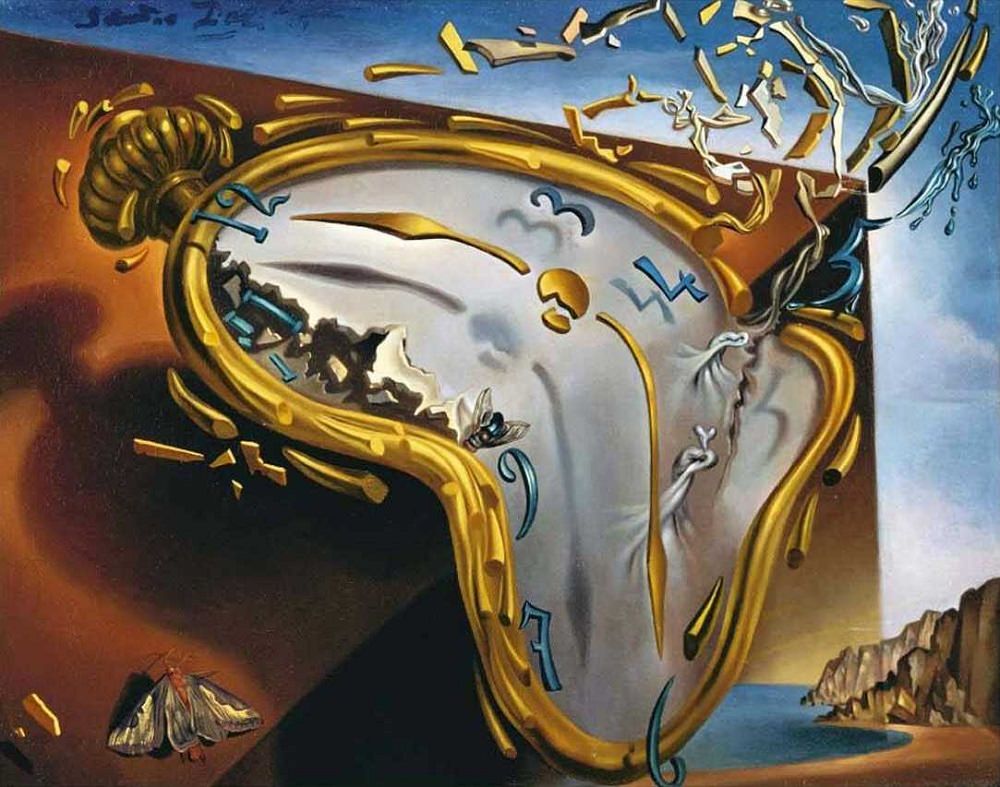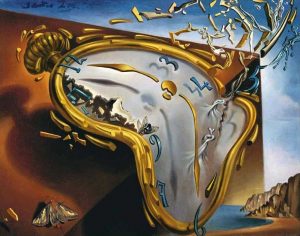Toward An Understanding of Time Magic
by Sodalis Harmony Pax
“A wizard is never late, nor is he early. He arrives precisely when he means to.” JRR Tolkien
Timing is a major part of the magical tradition. For example, many people use astrology, planetary hours, and moon phases in their ritual planning. According to some, the new eon began when the sun began to rise in the sign of Aquarius on the spring equinox, marking the age of Aquarius. In the past, it had risen in the sign of Pisces. The spring equinox, which is when the sun enters Aries, is also our Thelemic new year. Many Thelemites make Abramelin oil during the full moon.
This depends on a linear understanding of time. Here, timing is used as a tool within magical practice. But time itself can also be affected by magical practice. Many people believe that we can go forwards and backwards in the three dimensions of space, but only forwards in time. But according to modern physics, time may not be linear. This means that not only can the past affect the future, but the future can potentially affect the past. This opens up a lot of implications for occultists.
Incorporating Time Symbolism into Ritual
One reason why this is article is about an understanding of time magic, and not its knowledge, is because Binah is the sephirah representing time, death, and limitation.
What this implies is that figures that are beyond Binah, up in the supernal triad, are also beyond the control of time. This is the archetypal realm of the godforms. It’s hard to establish proper control over time without establishing a proper relationship with time, or kronos. Moreover, opportunity – kairos – is something that people are always looking for within time, like how we seek parking spots within space.
If you want to get into a good relationship with time and opportunity, you can call upon these ideas in thought and deed. I like to call upon the trinity of Chronos, Kairos, and Aion. This is because they represent different aspects of time. Chronos is time itself, Kairos is opportunity, and Aion is the eternity in which time operates.
Gods of Time
Chronos – Time Itself
Chronos was an early god who ruled during the primordial age, whose wife was Ananke, or inevitability. Later on, Chronos or Saturn became the name of a Titan, the father of various gods such as Zeus, Poseidon, Demeter and Hades. One myth states that he tried to eat his children to keep them from taking over his reign. Time comes for everybody, including Time.
During the plentiful golden age, Saturn taught humans agriculture, which is why his symbol is a scythe. He also civilized fauns, nymphs and other fae by giving them laws and government. His festival, Saturnalia, takes place at the winter solstice under the sign of Capricorn, which is ruled by Saturn.
The Orphics taught that Chronos was born from earth and water, and never ages. Some contrast this Chronos with Aion, or eternity, saying that Chronos is finite, rather than infinite, time.
To call upon Saturn, use this Orphic Hymn:
Orphic Hymn to Saturn
Incense to be used: Storax. (Liquidambar orientalis)
Etherial father, mighty Titan, hear, great fire of Gods and men, whom all revere:
Endu’d with various council, pure and strong, to whom perfection and decrease belong.
Consum’d by thee all forms that hourly die, by thee restor’d, their former place supply;
The world immense in everlasting chains, strong and ineffable thy pow’r contains
Father of vast eternity, divine, O mighty Saturn [Kronos], various speech is thine:
Blossom of earth and of the starry skies, husband of Rhea, and Prometheus wife.
Obstetric Nature, venerable root, from which the various forms of being shoot;
No parts peculiar can thy pow’r enclose, diffus’d thro’ all, from which the world arose,
O, best of beings, of a subtle mind, propitious hear to holy pray’rs inclin’d;
The sacred rites benevolent attend, and grant a blameless life, a blessed end.
Kairos – Opportunity
The youngest son of Zeus, Kairos or Tempus (to the Romans) represents the appointed time, the right time, compared with Saturn which is time itself, or Aion, which is eternal time. One interesting fact is that Chronos is the youngest son of heaven and earth, Zeus is the youngest son of Chronos, and Kairos is the youngest son of Zeus.
A bronze statue of Kairos is known in literature, made by the famous Greek sculptor Lysippos. It stood at his home, in the Agora of Hellenistic Sikyon. The following epigram by Poseidippos was carved on the statue:
“Who and whence was the sculptor? From Sikyon.
And his name? Lysippos.
And who are you? Time who subdues all things.
Why do you stand on tip-toe? I am ever running.
And why you have a pair of wings on your feet? I fly with the wind.
And why do you hold a razor in your right hand? As a sign to men that I am sharper than any sharp edge.
And why does your hair hang over your face? For him who meets me to take me by the forelock.
And why, in Heaven’s name, is the back of your head bald? Because none whom I have once raced by on my winged feet will now, though he wishes it sore, take hold of me from behind.
Why did the artist fashion you? For your sake, stranger, and he set me up in the porch as a lesson.”
Aion – Eternal Time
Aion was a later Greek god that represented eternal and unbounded time, unlike Chronos, who represented time experienced by mere mortals which could be divided into periods like years. Aion is often pictured with earth goddesses such as Gaia or Tellus. He is often pictured either turning the Zodiac as a wheel, or wearing it wrapped around his body.
Carl Jung really liked Aion, and modern thinkers added their own ideas, but this goes far beyond the scope of this essay. As the majority of existing prayers to Aion come from the later Gnostic tradition, where he is syncretized with Helios (the Sun) and invoked as a savior figure, it would be better to come up with our own prayers to Aion as the god of eternity.
A Time Travel Meditation
Here is a simple ritual to heal the past by means of visualization, the path which we use to connect the physical world with the formative one. Take black, white and grey candles and arrange the candlesticks in the shape of a triangle. At the top goes the grey candle for Aion, on the left side facing you, the black for Chronos, and on the right, the white for Kairos.
First, light the candle for Aion and recite the invocation that you have written for him. Then light the candle for Chronos and say the Orphic Hymn. Then light Kairos and recite the story of Lysippus’ bronze statue. At the end of each recitation, say (the name of the god), we bid you welcome.
Close your eyes and gaze upon the warm, familiar darkness of your mind’s eye. Visualize yourself walking down a forest path until you reach a large tree with an open doorway in the middle.
To each side of the doorway, there are statues of Kairos, with his forelock, winged feet, holding a giant razor in one hand, and a giant peppermint scented candle in the other. You take one of the candles and walk into the doorway. Immediately you see a spiral staircase going downward into the tree. With every few steps you take, you see a date and time in front of you, carved on the side of the stairwell. Think of the date and time in the past you would like to visit, and walk down the stairs to where you see this date.
As soon as you see the date you want to return to come up on the wall, you touch it and a small door appears in the wall, with a bracket on the side to put your candle in. You walk along the step, which has now widened to a landing, and as you open the door, you find yourself stepping into the world of that date and time. You walk through the landscape until you see yourself. What are you doing? Immediately, you step into your past body. What information would you like to get? What things would you like to change?
When you are done doing all you need to do in this time period, walk back the way you came and soon you will see a small wooden door. Open the door and you are back in the stairwell. It’s now time to take the candle and walk upstairs. Once you are at the top of the stairs, you walk out of the tree and put your candle back into the Kairos statue’s hand, thanking him for the opportunity to go backwards in time.
You keep walking in the forest until you see a small wooden door. Open the door, and you are back in the warm darkness of your mind’s eye. Hear the small sounds of traffic and other things around you, feel the air and rub your hands together. When you are ready, open your eyes.
At this time, write down the things you saw and the changes you have made. After you are done, you can make an offering to Chronos, Kairos or Aion. Make sure to thank them for coming while blowing or pinching out each candle. At the end of the ritual, do a license to depart and, if you want, a banishing.


